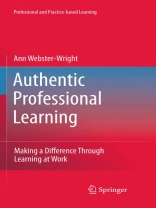Table of Content
PART A: INTRODUCTION. Prologue.- 1.- Professional Learning at Work.- 1.1 Genesis of the Research.- 1.2 Intent of the Book.- 1.3 Research Findings.- 1.4 Conceptualising Authentic Professional Learning.- PART B: EXPLORATION.- 2.- Critical Review of Professional Development.- 2.1 Interdisciplinary Inquiry into Professional Learning.- 2.1.1 Professional education.- 2.1.2 Workplace learning.- 2.1.3 Adult education.- 2.1.4 Integrating the research fields.- 2.2 Current Working Context for Professional Learning.- 2.2.1 Certainty through regulation and control.- 2.2.2 Uncertainty related to change and complexity.- 2.3 The Concept of Learning.- 2.3.1 Learning theories.- 2.3.2 The nature of professional learning.- 2.3.2.1 Learning from experience.- 2.3.2.2 Learning through reflective action.- 2.3.2.3 Learning mediated by context.- 2.3.3 The nature of professional knowledge.- 2.3.3.1 Knowledge as a commodity.- 2.3.3.2 Knowing-in-practice.- 2.3.3.3 Embodied knowing.- 2.4 Problematising Practice and Research.- 3.- Phenomenological Conceptual Framework.- 3.1 Wondering About Phenomenology.- 3.2 Phenomenology as a Conceptual Framework.- 3.2.1 Phenomenological philosophy.- 3.2.2 Phenomenological concepts.- 3.2.2.1 Life-world.- 3.2.2.2 Being-in-the-world.- 3.2.2.3 Embodied knowing.- 3.2.2.4 Construction of meaning.- 3.2.2.5 Understanding.- 3.2.3 Philosophical assumptions of this research.- 3.3 Phenomenology as a Methodological Approach.- 3.3.1 Principles of phenomenological research.- 3.3.1.1 Phenomenological attitude.- 3.3.1.2 Phenomenological essence.- 3.3.2 Empirical phenomenology.- 3.3.2.1 Phenomenology as a scientific method.- 3.3.2.2 Phenomenology as evocation of lived experience.- 3.3.2.3 Phenomenology as rigorous yet evocative.- 3.4 Summary of Phenomenological Framework.- 4.- Empirical Phenomenological Methodology.- 4.1 Reflexive Methodology.- 4.2 Criteria of Quality in Research.- 4.3 Research Design.- 4.4 Rigour, Relevance and Reflexivity.- 4.5 Engaging With the Participants.- 4.6 Data Analysis.- 4.6.1 Dwelling with the data.- 4.6.2 Transformation of data.- 4.6.3 Developing the structure.- 4.7 Summary of Methodology.- PART C: UNDERSTANDING.- 5.- Authentic Professional Learning.- 5.1 Professional Life-World.- 5.2 Situations Where Professionals Learn. 5.3 Structure of Authentic Professional Learning.- 5.3.1 Overview of authentic professional learning.- 5.3.2 Learning as change in professional understanding.- 5.3.2.1 Change in professional understanding.- 5.3.2.2 Learning transitions.- 5.3.2.3 Varying types of transitions.- 5.3.2.4 Gina: A whole new way of looking at everything.- 5.3.3 Learning through engagement in professional practice.- 5.3.3.1 Active engagement in professional practice.- 5.3.3.2 Caring about practice.- 5.3.3.3 Uncertainty in learning.- 5.3.3.4 Revealing the novel.- 5.3.3.5 Mary: Putting the pieces together.- 5.3.4 Learning through interconnection over time.- 5.3.4.1 Circuitous and iterative web.- 5.3.4.2 Imagination draws together.- 5.3.4.3 Dynamic interaction with others.- 5.3.4.4 Olivia: How will I do it differently next time? 5.3.5 Learning as circumscribed openness to possibilities.- 5.3.5.1 Openness to possibilities.- 5.3.5.2 Opportunities and constraints of professional context.- 5.3.5.3 Resolution of tensions.- 5.3.5.4 Sam: The theory doesn’t match reality.- 5.4 Summary of Authentic Professional Learning. 6.- Making Meaning Through Professional Learning.- 6.1 Learning as Part of Being a Professional.- 6.2 Ways of Being a Professional.- 6.2.1 Being Gina: Learning as an interesting journey.- 6.2.2 Being Mary: Learning as problem solving.- 6.2.3 Being Olivia: Learning as personal growth.- 6.2.4 Being Sam: Learning as an challenging ideas.- 6.3 Making Meaning as a Professional. PART D: INTEGRATION.- 7.- Rhetoric Versus Reality.- 7.1 Dealing with Dissonance.- 7.1.1 Credibility of the evidence about CPL.- 7.1.2 Describing the dissonance.- 7.2 Problematic Issues in CPL.- 7.2.1 Questioning assumptions.- 7.2.2 Engaging with uncertainty.- 7.2.3 Imagining conversations.- 7.2.4 Voicing what is valued.- 7.3 Wider Context of Professional Dissonance.- 7.3.1 Competing life-world discourses.- 7.3.2 The hidden nature of dissonance.- 8.- Authenticity in Professional Life.- 8.1 Ontological Claims.- 8.1.1 What does ‘being a professional’ mean? 8.1.2 Being-in-the-professional-world.- 8.1.3 Ontological dimensions of learning.- 8.2 Authenticity in Professional Life.- 8.2.1 Mavericks and Impostors.- 8.2.1.1 Sally: I’m never sure if what I’m learning is the truth.- 8.2.1.2 Being an authentic professional.- 8.2.2 The concept of authenticity.- 8.2.2.1 Social construction of self.- 8.2.2.2 Public professional world.- 8.2.2.3 Being authentic.- 8.3 Transformation Through Learning.- 8.3.1 Change through learning experiences.- 8.3.1.1 Nerida: Learning to do what a professional does.- 8.3.1.2 Way of being a professional.- 8.3.2 Transformative learning.- 8.4 Implications of Ontological Claims.- 9.- Implications for stakeholders.- 9.1 Principles of Authentic Professional Learning.- 9.1.1 Awareness as a resource.- 9.1.2 Learning relationships.- 9.1.3 Challenging support.- 9.1.4 Learning culture.- 9.2 Changing Support for Professional Learning.- 9.2.1 Culture of inquiry.- 9.2.2 Reflexive authenticity.- 9.2.3 Cultural change.- 9.3 Models of Support for Authentic Professional Learning.- 9.3.1 Authentic professional learning support groups.- 9.3.2 Existing models for supporting learning.- 9.3.3 Existing resources for supporting learning.- 9.4 Implications for Undergraduate Education.- 9.4.1 Preparation for the realities of practice.- 9.4.2 Learning to be a professional.- PART E: CONCLUSION.- 10.- Making a Difference in Professional Learning.- 10.1 Ontology and Epistemology in Learning.- 10.2 Potential of Authentic Professional Learning.- 10.3 Making a Difference in Supporting learning.- 10.4 A Way Forward for Research on Learning.- 10.5Possibilities for Change.- References.- Appendices.- A: Interview Questions.- B: Data Analysis Examples.- C: Summaries of Learning Situations Described by Participants.












